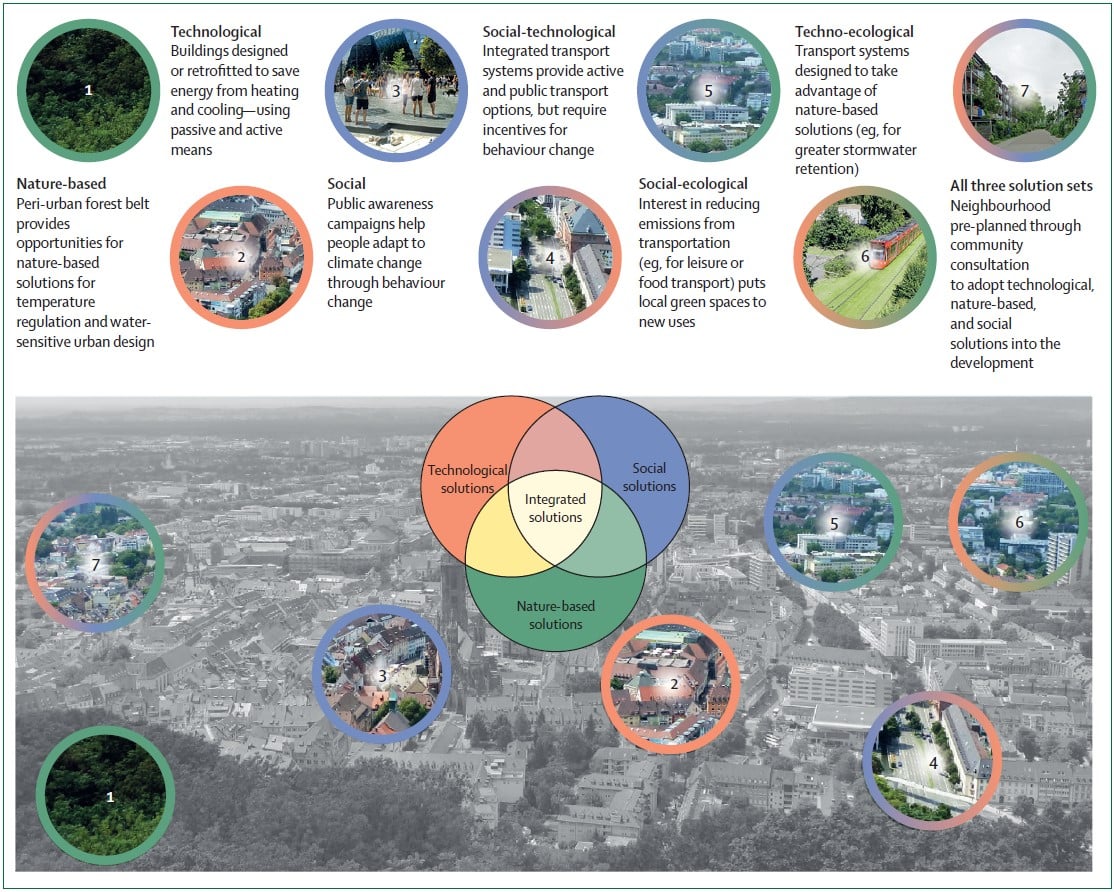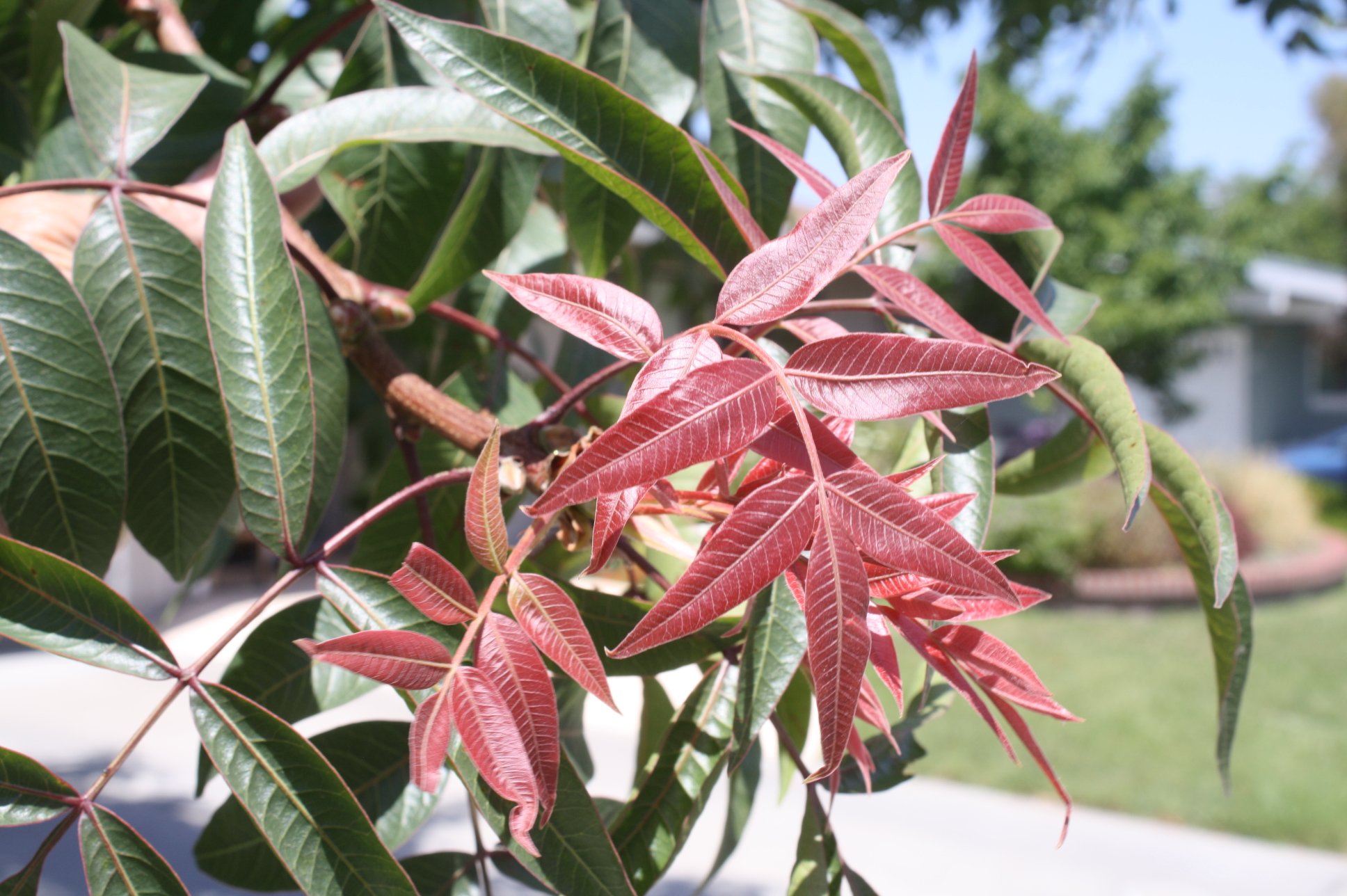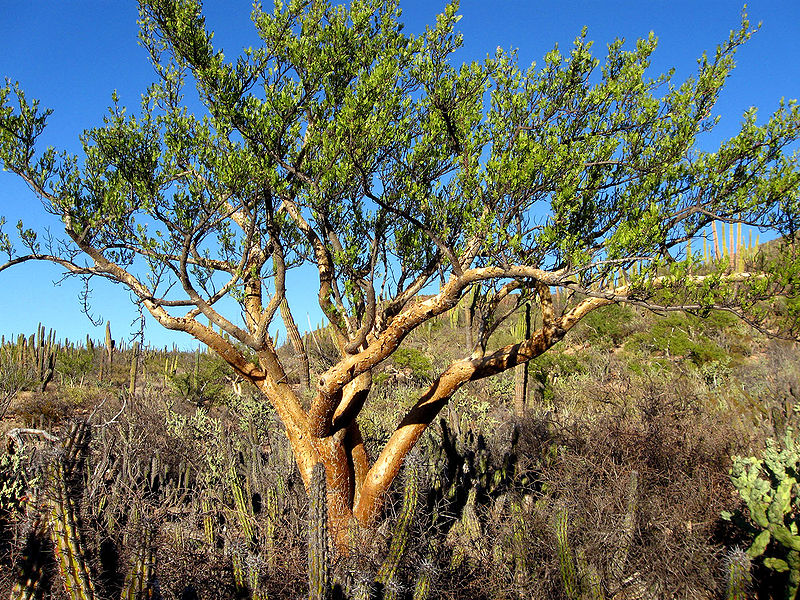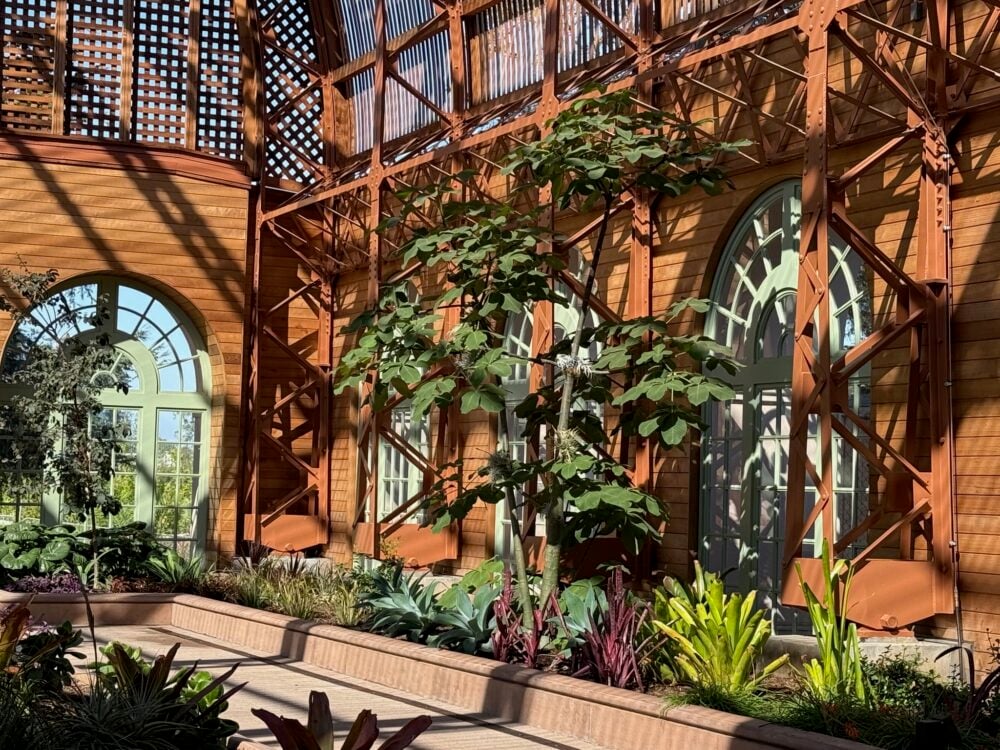

Contributor
- Topics: Archive, Plants You Need

Camellia reticulata. is enjoying a revival of botanical interest. For some time, this large-flowered camellia from the Yunnan province of China has been the knot in the middle of the rope in a tug-of-war between “lumper” and “splitter” taxonomists working with the genus. A long-term study of this particular section of the genus, using morphological and molecular tools, shows promise for resolving this botanical debate.
Though Camellia reticulata has been somewhat out of fashion in recent decades, the time may be right for a resurgence of horticultural interest in this broad-leafed evergreen, distinguished by its extravagantly sized blooms. Two recent horticultural events—the flowering of a titan arum (Amorphophallus titanum) at the Huntington and the introduction of the Hidden Valley hibiscus (both featured in recent issues of Pacific Horticulture)—suggest that big is “in” again. Perhaps it is time for a fresh assessment of the reticulata, which is known to produce flowers up to eleven inches in diameter.
Camellia reticulata is a gray-barked shrub or tree of as much as fifty feet in height, the tallest of the species. The three- to five-inch long, elliptical leaves are heavily serrated and dull green; the species name derives from the netted pattern of leaf venation. The flowers on wild plants will be four inches wide; on hybrids, they are usually larger. Located at the branch tips, the flowers appear in various tints of red and pink, approaching white in some of the cultivars. Individual petals may be indented or somewhat crinkled, giving a variety of forms to the flowers. The fruit is a light brown, three-segmented capsule, about two inches in diameter.
While Camellia reticulata created a horticultural stir in the Western world on at least two occasions in the last 300 years, its history in its native China goes back much further. According to Stirling Macoboy in his magnificent Colour Dictionary of Camellias, the first published reference to C. reticulata was in the year 590 in an herbal text. Colonel Durrant, in a 1967 lecture on the species dated the Chinese cultivation of C. reticulata to the ninth century in its native Yunnan province. By the eleventh century, seventy-two cultivars had been selected. The oldest reticulatas still living sprouted not long after that; indeed, a specimen of ‘Mayetaohong’ at Panlong Monastery dates to 1347. The peak of Chinese enthusiasm for the species seems to have been during the Ming Dynasty (1368 to 1644), when there was a flurry of interest in, and writing about, reticulatas. A recent resurgence of Chinese interest has ballooned the total number of Chinese cultivars to 120.

The earliest records of reticulata introductions to the horticultural world outside of China seem to trace to a single cultivar. ‘To-Tsubaki’, which left China late in the seventeenth century (the Qing Dynasty) for Japan. ‘Captain Rawes’, as this cultivar was later named, was also the first reticulata to come to the Western world, making the voyage in 1820 to England. British botanist John Lindley in fact described Camellia reticulata from a specimen of ‘Captain Rawes’. The only reticulata that Walter Lammerts could find in California to verify the authenticity of his new reticulata importations in 1948 was a specimen of ‘Captain Rawes’ at the University of California Botanical Garden in Berkeley. That plant still exists in Berkeley, and elsewhere, yet the cultivar died out in China. It was reintroduced to China in 1974, three centuries after its departure, and given the name ‘Guixia’ (‘Returned Glory’).
A few other reticulata cultivars found their way to the Western world before the middle of the twentieth century. ‘Songzilin’ (syn. ‘Robert Fortune’, ‘Pagoda’, ‘Pine Cone Scale’) was introduced during the nineteenth century, although the exact date is still debated. George Forrest was the first Westerner to wild-collect Camellia reticulata early in the twentieth century. The single-flowered plants that Forrest collected were clearly different from the semi-double ‘Captain Rawes’ from which Lindley had described the species, leading botanist J Robert Sealy to name the wild form C. reticulata forma simplex in his monograph published in 1958.
The dam finally burst open in 1948 whenWalter Lammerts of Rancho del Descanso (now Descanso Gardens in La Canada) and Ralph Peer, another camellia enthusiast in Hollywood, both imported a set of twenty reticulata cultivars. Though the two made their contacts and importations separately, they soon learned of each other’s activities. Fumigation with methyl bromide, by agricultural department inspectors, resulted in the loss of some plants, but through sharing with each other, Descanso and Peer were able to establish fifteen Chinese cultivars, which were introduced in 1952.
Some have suggested that the actual number of cultivars imported was lower than commonly published, due to errors in the identification of the plants. However, one of the disputed cultivars, ‘Xiaoguiye’ (syn. ‘Small Osmanthus Leaf’), was recently found at Descanso Gardens, suggesting that the fifteen cultivars may, in fact, have been received there, and that the jumbling of their identities occurred later. Nevertheless, the bulk of more than 800 reticulata cultivars listed in the 23rd edition of the Camellia Nomenclature (1999) trace their heritage to those fifteen Chinese cultivars brought to California in 1948.

Reticulatas in the Wild
With reticulatas having the potential to livefor 600 or more years, the entire cultivated history of the species could be thought of as being only about two life cycles removed from the wild. Any reasonable cultivation regime begins with observing plants in the wild as Jennifer Trehane has done in her recent book on camellias (1998).
Camellia reticulata is found naturally in China, near the border of Yunnan and Sichuan provinces, where it is known as nanshancha, the southern mountain camellia. Reticulatas are found at an elevation of approximately 6000-8000 feet (1800-2500 meters) in this mountainous region. The dull, waxy leaves (better at reflecting high levels of ultra-violet light) suggest that this plant is well adapted to higher elevations. It would be interesting to go back a few thousand years to observe its range when there was less population pressure in the region.
Reticulata is a forest plant, coming from open woodlands described by Trehane as pine scrub. Evergreen and deciduous oaks form an important part of the overstory along with several species of pine. On disrupted sites, Camellia reticulata and its close relatives are quite happy to be the overstory. Soil types vary throughout the region, but most authorities agree that the soil one would expect to find in a forest—loose, acidic, and organic—is the type preferred by the camellias.
The Yunnan region of western China has a mild climate, with warm and dry winters. Average temperature for January is 46° F (7.8° C) and in July 68° F (19.9° C). The annual rainfall is roughly thirty-eight inches (almost one meter); the bulk of the rain falls during the summer months of May through September, with virtually no rain during the flowering period in the early part of the year.
In the Garden
Understanding these conditions in the wild helps in selecting the best site in the garden for reticulata camellias. Look for a site with loose, acidic soil that has good light and a slight slope for air drainage. Exposure may vary depending upon where the garden is located along the West Coast. Some tree cover to provide shade from the afternoon sun is helpful in Southern California, especially for young plants, but growers in the Northwest will want some overhead frost protection for the winter.
A comparison of the native conditions to the garden site can also help in developing a management program. The array of climates on the Pacific Coast means that a comparison to Yunnan would require oversimplification. Two broad observations can be made, however. While both regions offer generally mild climates, the rainfall distribution pattern is distinctly different.
Thanks to the mild climates on the West Coast, reticulatas can be grown throughout the region with little difficulty. Reticulatas are cold hardy enough (with some protection) for Seattle and the San Juan Islands to the north, yet can tolerate the heat of a Los Angeles summer in the south. Inland sites present problems due to their more extreme winter low temperatures. Very few camellias will tolerate temperatures approaching 0° F (-18° C). However, readers in the colder zones will be buoyed by the camellia trials at the Edinburgh Zoo in Scotland, where several reticulata cultivars and hybrids have survived 1° F.
Water presents a greater challenge. Many parts of the Pacific Coast have as much rain as Yunnan, or more. However, summer is the dry season here, with the bulk of our rain falling in winter and spring. The extra water in the winter is apparently not a problem; camellia show hobbyists link winter water to increased flower size. The critical period for irrigation occurs in the summer months, beginning with the first flush of growth in spring and continuing until temperatures drop again in the fall. Experience at Descanso Gardens suggests that the first flush of growth has the greatest need for water; reticulatas seem more prone to having their new growth wilt from lack of water, low humidity, or high temperatures than do other camellias.
Reticulatas also seem to prefer more light than other camellias. They do well in nearly full sun, even in southern California. Full sun results in a more densely branched and foliaged plant, overcoming one of the criticisms of this group. Given the large leaf-surface area, a break from the hot afternoon sun is usually appreciated, especially by recent transplants. A regime that gradually increases light throughout the establishment period should be followed.
To round out their easy culture, reticulatas are also light feeders. Every grower has a preferred fertilizing regime, but most agree on cottonseed meal as a key component of their program. Cottonseed meal is an organic fertilizer offering slow release characteristics; it provides six percent nitrogen and the ideal N-P-K ratio of 3-1-1. It also helps acidify the soil, an important consideration in many locations in the West. At Descanso Gardens, the first spring feeding is a four-to-one mix of cottonseed meal and blood meal; a second feeding follows about six to eight weeks later with straight cottonseed meal. Occasionally, remedial fertilization is done with a low nitrogen, acidifying fertilizer containing trace elements to help overcome soil pH problems; the ideal pH range is 5.5 to 6.8.
Pruning recommendations for reticulata camellias are much like those for small trees. The main goal is to keep an open center and to avoid crossed limbs. Although reticulatas can tolerate heavy pruning (as evidenced by an unintentional experiment involving falling oak trees), most growers prefer to keep the pruning light. One caution is that reticulatas have a tendency to develop branch dieback from severe heading cuts; as with most woody plants, thinning cuts are preferred.
One special technique that a home gardener may want to consider is disbudding. Disbudding involves the selective removal of some floral buds, generally leaving only one per flowering shoot. This enables flowers to open without competition and to develop a better flower form. It also is reputed by show hobbyists to increase the size of the flowers from large to ridiculously large.
Pests are usually not a problem for camellias in general, and happily this extends to reticulatas. However, even a well-sited, well-tended reticulata may need help with root rot, stem dieback, scale, or mites over the course of its long life. Consult a recent camellia reference for the latest recommendations for treatment.

Reticulata Popularity
So, what has kept an easily grown, large-flowered, winter-blooming, broadleaf evergreen from gaining more garden acceptance over the last fifty years? Probably two factors are involved: limited nursery availability of reticulatas, and lack of recognition of their distinctive characteristics. The first factor will likely remain in effect until someone learns to root reticulata cuttings with an acceptable success rate. Grafting plants that have only a limited commercial interest is not a good business proposition.
The second factor is resolvable through observation and by accepting the plant on its own terms. Camellia reticulata is different from the more familiar Japanese species, C. japonica and C. sasanqua. The biggest difference is that reticulata is more arborescent, growing into a tree fifty feet (fifteen meters) tall over time. A lateral limb more than eighteen feet long has been measured on a fifty-year-old specimen of ‘Dayinhong’ (syn. ‘Shot Silk’) at Descanso Gardens. Trying to maintain a reticulata as a dense shrub, as most do with C. japonica, is more labor intensive than landscape growers generally desire. The natural habit of reticulatas compares well with other small, flowering trees such as magnolias and dogwoods.
While it is tough to compete with the grandeur of Magnolia grandiflora covered in dinner-plate-sized flowers, or the two-season color display of Cornus kousa, Camellia reticulata has ornamental characteristics that warrant consideration. It offers a long flowering season, the early sasanqua-reticulata hybrids opening in December and the latest cultivars flowering reliably into May. Flowering is followed by new growth in which the young leaves are often red, contrasting nicely with the handsome, dark, evergreen leaves. Thus, reticulatas provide color interest at a time of year when few other trees do. Large, corky brown fruits ripen in the fall months, further extending the season of interest.
The challenge comes with the realization that an average home garden may provide room for only one full-grown reticulata. Reticulatas can, of course, be kept smaller through heavy pruning, or they can be grown on single stems as standards, which occupy less space. Container growing restricts the plant’s growth and can be useful in marginal climates where the plant must be brought under shelter for the winter. A few selections, such as ‘Valentine Day’, are slow growers, while others have growth habits atypical of the species, as in the mounding habit of ‘Captain Rawes’ or the gracefully arching form of ‘Juban’ (syn. ‘Chrysanthemum Petal’). A genetic dwarf, ‘Hentiengao’, is occasionally available.

Color, Form, and Season
For use as a small specimen tree, there are fifty or so cultivars and hybrids of Camellia reticulata commercially available. Reticulatas are mostly available with red, pink, and variegated blossoms. A few, such as ‘Chrissie’s Retic’ or ‘White Retic’, are nearly white, while others shade into the lavender or purple range as seen in ‘Fiesta Grande’ and ‘Zipao’ (syn. ‘Purple Robe’). Flower forms vary from single through formal double, but most are semi-double or double. Most reticulatas are relatively late-blooming, peaking between February and April. Some, like the sasanqua-reticulata hybrids will open earlier in the year. There is also a range in flower size from the medium (three- to three-and-a-half-inch) ‘Juban’ to gargantuan ‘Dr. Clifford Parks’, ‘Harold L Paige’, and ‘Queen Bee’—these often reaching ten inches across.

A revival of interest may result in expanding the selection of reticulatas available. Much of the breeding to date has focused on hybridizing them with Camellia japonica to preserve the large flower on a dense, landscape shrub, or to produce the biggest, reddest flower possible. Some future goals for reticulata breeding include an expanded color range, the introduction of fragrance, and a picotee flower, all of which are underway in various parts of the world.
Still, the array of reticulatas available today represents at least eleven centuries of selection and breeding. The many cultivars produced to date show tremendous landscape merit if used properly. This large-flowered, small tree truly deserves a fresh look from Pacific Coast gardeners.
Camellia reticulata Resource Guide:
Major collections of Camellia reticulata cultivars can be seen in Southern California at:
Descanso Gardens, La Canada Flintridge, CA, 818/952-4400
Huntington Botanical Gardens, San Marino, CA, 626/405-2100
A few cultivars of Camellia reticulata can be seen at these gardens:
Filoli Center, Woodside, CA 650/364-8880
Strybing Arboretum & Botanical Gardens, San Francisco, CA, 415/661-1316
UC Botanical Garden, Berkeley, CA, 510/642-3343
Mendocino Coast Botanical Gardens, Mendocino, CA, 707/964-4352
Washington Park Arboretum, Seattle, WA, 206/325-4510
Nursery Sources:
Nuccio’s Nurseries, Inc (wholesale, retail, mail order)
3555 Chaney Trail, Altadena, CA 91003
626/794-3383
Berkeley Horticultural Nursery (retail)
1310 McGee Avenue, Berkeley, CA 94703
510/526-4704
Digger Pine Nursery (retail)
7555 Baldwin Dam Road, Folsom, CA 95630
916/988-6450
Heartwood Nursery (retail)
525 South Franklin, Fort Bragg, CA 95437
707/964-3555
For Further Reading
Bartholomew, Bruce. 1981. Additional introductions of Camellia reticulata cultivars from Yunnan to California. Camellia Journal 36(2):5-6.
Dunmire, John R, Jim McCausland, and the editors of Sunset Books. Azaleas, Rhododendrons, and Camellias. Sunset Books, Menlo Park, CA.
Durrant, Colonel T. 1967. Some comments on Camellia reticulata. American Camellia Yearbook 22:103-119.
Gonos, Arthur A, editor. 1999. Camellia Nomenclature. 23rd edition. Southern California Camellia Society, La Verne, CA.
Kunming Institute of Botany. 1986. Yunnan Camellias of China. Science Press, Beijing.
Lammerts, WE. 1950. The new Camellia reticulata hybrids: the story of their discovery, importation and propagation. American Camellia Yearbook 5:1-11.
Macoboy, Stirling. 1992. The Colour Dictionary of Camellias., 4th edition. Stirling Macoboy Books, Neutral Bay, Australia.
Robertson, Bruce. 1999. Camellia trials at the Edinburgh Zoo. International Camellia Journal 31:87-89.
Sealy, J Robert. 1958. A revision of the genus Camellia. Royal Horticultural Society, London.
Trehane, Jennifer. 1998. Camellias: The Complete Guide to Their Cultivation and Use. Timber Press, Portland, OR.
Yu, Te-tsun and Bruce Bartholomew. 1980. The origin and classification of the garden varieties of Camellia reticulata. American Camellia Yearbook 41:112-138.
Share:
Social Media
Garden Futurist Podcast
Most Popular
Videos
Topics
Related Posts

Ground Up Science for Greener Cities with Garden Futurist Dr. Alessandro Ossola
Spring 2023 Listen to the Podcast here. Alessandro Ossola is a scientist who gets very excited about the challenge of climate change allowing for an

Readying Urban Forests for Climate Realities with Garden Futurist Dr. Greg McPherson
Winter 2023 Listen to the Podcast here. “Going from the mow and blow to a more horticulturally knowledgeable approach to maintaining the landscape. And that

Welcome, Greywater, to the Garden
Summer 2022 Oh, summer: delightful warm air, tomatoes swelling on the vine, fragrant blooms on an evening stroll. When it’s warm and rainless, how is

Big Tree-Data and Big-Tree Data with Garden Futurist Matt Ritter
Summer 2022 Listen to the full Garden Futurist: Episode XV podcast here. We are in an environmental crisis right now in many parts of California








Responses